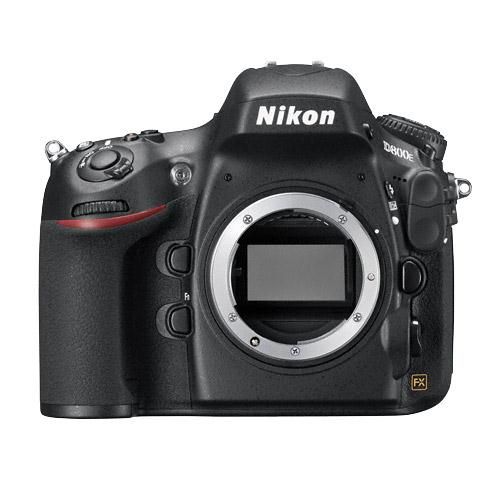MINUSCULE DETAILS, MONUMENTAL IMAGES, BROADCAST QUALITY VIDEOS
Key Features
Newly developed Nikon FX-format CMOS sensor with 36.3 effective megapixels
The D800/D800E employ a Nikon FX-format CMOS sensor (35.9 x 24.0 mm) with 36.3 effective megapixels, the world's highest number*. It renders texture, nuances and details equivalent to those a high-end medium format camera can deliver.
Advanced Scene Recognition System with enhanced accuracy realized by 91K-pixel RGB sensor
Advanced Scene Recognition System realizes face detection during optical viewfinder shooting. It achieves highly accurate control of auto functions such as AF, AE and AWB utilizing face detection information and detailed scene analysis information.
Multi-area mode Full HD D-Movie that enables a variety of expressions in two formats
It is possible to record 1,920 x 1,080/30p Full HD and HD movies in either of two formats that are FX- and DX-based. You can select the format according to your creative intentions.
Image sensor
Nikon FX-format CMOS sensor with 36.3 effective megapixels
The D800/D800E render levels of texture, nuance and detail to your photography that, until now, have been the exclusive domain of the complicated medium-format system. Define every eyelash, every line in tree bark, and every shimmer of light. Savor the exceptional depth in your still images — with the combination of an astounding 36.3 effective megapixels, the world's highest*, and the outstanding performance of NIKKOR lenses, you can. Enlarge them as big as A1 poster-sized prints (59.4 x 84.1 cm/23.4 x 33.1 in.) at 200 dpi, or crop aggressively to reach the composition you desire, all without sacrificing the detail and tonal range of the original. In order to maintain clean, high-resolution images, 14-bit A/D conversion within the sensor and a high signal-to-noise ratio deliver phenomenal images in a diverse array of situations. The image sensor's incredible potential does not stop with photography, either. For cinematographers ready to put their exceptionally sharp NIKKOR lenses into action, the D800/D800E's 36.3 effective megapixel data is efficiently processed for exquisite 1080p broadcast quality video at 30p.
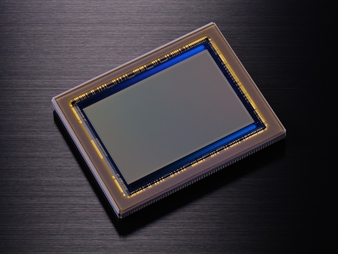
Standard ISO 100 to ISO 6400, range expandable to ISO 50 to 25600 equivalent
High-resolution, studio-quality images shouldn't be restricted to the studio. The D800/D800E set a new benchmark for high-resolution D-SLR cameras, with crisp clean images across a wide ISO range. Flexibility like this opens up new imaging opportunities for both still photographers and cinematographers alike during the "magic hour", the time just before dawn or at dusk when available light is often beautiful but scarce. Even at high ISO settings, the camera's intelligent noise reduction systems manage noise without sacrificing fine details, giving the D800/D800E the edge. The difference can even be seen in low-contrast subjects such as hair and grass textures, which are often essential elements of cinema as well as high-resolution portraits and landscape images. High image quality at higher ISOs also means that you can shoot still images handheld more confidently, knowing that fast shutter speeds will reduce blur.
ISO 100
ISO 200
ISO 400
ISO 800
ISO 1600
ISO 3200
ISO 6400
A strategic approach to turn light to your advantage
Combining both high-resolution performance and a wide ISO sensitivity range has finally become a reality. Nikon engineers have developed intelligent new methods to manipulate light transmission to the sensor's photodiodes: from the optical low-pass filter and on-chip gapless micro lenses to the image sensor's internal design, every measure has been taken to maximize and improve light transmission in order to deliver crisp, brilliant images with significantly less noise. All this is possible under a wide variety of lighting conditions, enabling you to get the most out of your NIKKOR lenses.
Optical low-pass filter optimized for sharpness on the D800
Reducing false color and moiré is the main job of the optical low-pass filter located in front of the image sensor. However, this benefit is generally gained with a small sacrifice of sharpness. Moiré occurs in scenes containing repetitive details, such as strong vertical lines in architecture. Finding the right balance between benefits and sacrifices is the key to higher image quality, and that is what the D800's optical low-pass filter delivers. As a result, the astounding 36.3 megapixels unleash their potential through an optimized balance between sharpness and effectively prevented moiré and false color. Furthermore, the multi-layer structure of the D800 low-pass filter utilizes layers of antireflective coating that have been optimized for the camera, contributing to sharper and clearer images.
The ultimate attention to detail — the D800E
D800E
Nikon engineers have developed a unique alternative for those seeking the ultimate in definition. The D800E incorporates an optical filter with all the anti-aliasing properties removed in order to facilitate the sharpest images possible.
This is an ideal tool for photographers who can control light, distance and their subjects to the degree where they can mitigate the occurrence of moiré. Aside from the optical filter, all functions and features are the same as on the D800.
Note: The D800E carries an increased possibility that moiré and false color will appear, compared to the D800. IR cut and antireflective coating properties of the optical filter remain the same with both versions.
The original light and light separated in horizontal direction with the low-pass filter 1 are transmitted through the low-pass filter 2 with the wavelengths unchanged. The original light is transmitted as it is, and light separated with the low-pass filter 1 changes only direction vertically (two points are maintained). By converting polarized light into circularly polarized light with the wave plate, two points are divided into four points.
With the D800, light passing through the lens that is separated in four segments using a low-pass filter is received by the image sensor. Because separation pitch of the low-pass filter is much shorter than that of the image sensor, moiré and false color reduction can be achieved with minimal deterioration of resolution.
By employing the optical glass, the original light and light separated in vertical direction with the low-pass filter 1 is transmitted through the low-pass filter 2 as non-polarized light with the same optical path length. The low-pass filter 2 changes the direction of separated light to the opposite side to revert to the original optical path, and the combined light is transmitted to the image sensor as a single point.
With the D800E, the effects of the low-pass filter is removed, and the light is received by the image sensor at a single point, achieving higher-resolution images with minimal blur.
Comparison of resolution: D800/D800E have the same resolution of 36.3 megapixels
The D800E reproduces the texture of the stone pavement and twigs with higher resolution than the D800. It allows sharper rendering with depth.
Nikon Integrated Dust Reduction System that includes an Image Sensor Cleaning function
Any dust that reaches the image sensor results in unattractive spots on your images. To prevent this, the D800/D800E employ Nikon's Integrated Dust Reduction System, which includes a self-cleaning sensor unit with four different resonance frequencies to vibrate the optical low-pass filter and shake dust away from the sensor. This function can be set to operate automatically when the camera is turned on or off, or to manual.
EXPEED 3 image-processing engine: speed, versatility, and high performance
High-megapixel still images are detail-rich but data-heavy. With the D800/D800E, however, you don't have to sacrifice speed for this privilege. Dedicated to understanding speed and its role in image making, Nikon engineers designed a powerful EXPEED 3 image-processing engine exclusively for digital SLRs. From image processing and card recording to image playback and image transfer, EXPEED 3 manages massive amounts of data at faster speeds than EXPEED 2. Even with specialized processing features like Active D-Lighting and high ISO noise reduction, capture speed is not affected. EXPEED 3 is so powerful that it handles data-intensive tasks such as Full HD video recording at 30p with ease. You'll also notice the difference in your still images and videos through minimized noise and even richer colors and tones. In addition to these fundamental advantages, the D800/D800E reduce the kind of color phase shift that some cameras have difficulty with in similar situations.
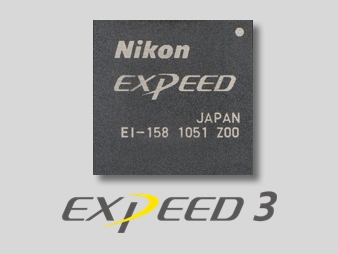
14-bit A/D conversion and 16-bit image processing for rich tones and natural colors
Tonal gradation is where an image transforms from simply representing life to taking on a life of its own. The D800/D800E do exactly that, with cutting-edge image processing that injects vital energy into your images. Black is rendered as pitch black, and shadow details are subtle and rich. Even under harsh, high-contrast light, where some cameras can fail, the D800/D800E's gradation remains smooth with abundant detail and tone all the way up the scale to pure white.
Lateral chromatic aberration reduction: Take full advantage of your NIKKOR lens collection
High-megapixel sensors can really test the quality of your lenses, but you can be confident that the combination of brilliant NIKKOR lenses and Nikon's intelligent processing measures will significantly reduce lateral chromatic aberration to give you incredibly natural-looking results. Unlike other correction methods that simply eliminate chromatic aberration, Nikon's method compensates for these color differences in a resolving index for each color, making it particularly effective in producing images with stunning edge-to-edge sharpness. Moreover, because these corrections are made regardless of the NIKKOR lens used, this feature contributes substantially to achieving the sharpest images possible.
Advanced Scene Recognition System with 91K-pixel RGB sensor
Nikon's revolutionary Advanced Scene Recognition System, introduced with the flagship D4 camera, is also employed in the D800/D800E. At its core is a 91K-pixel RGB sensor that meticulously analyzes each scene with the fine resolution. The RGB sensor can recognize your scene's colors and brightness with unprecedented precision, then use that information to implement various automatic controls and give you more natural-looking results. The real breakthrough, however, is that the sensor can detect human faces with startling accuracy when shooting through the optical viewfinder. Along with face detection, detailed scene analysis is utilized to support more accurate autofocus, auto exposure and i-TTL flash exposure results in a diverse range of compositional and lighting situations. The improved subject tracking is most noticeable when using 3D-tracking, which can maintain a focus on moving subjects smaller in size than with previous generations.
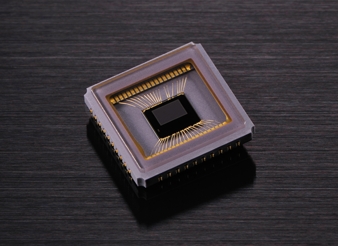
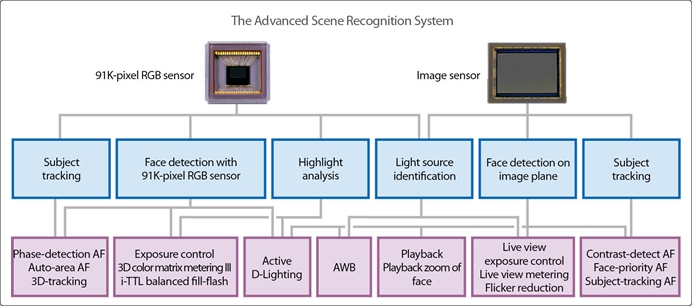
More accurate face detection in auto-area AF and subject tracking in 3D-tracking
Auto-area AF and 3D-tracking are AF-area modes unique to Nikon that use your subject's color and brightness information to detect focus. With the D800/D800E and their more precise information and subject recognition advancements, expect big steps forward for both AF-area modes when taking high-quality still images. In auto-area AF, the camera can genuinely detect human faces and focuses on them immediately — useful when faces are a priority and there's no time to choose focus points. When using 3D-tracking, the sensor's fine resolution combines with a specifically optimized AF algorithm to realize unprecedented subject tracking precision, recognizing detailed patterns to keep your subject in sharp focus.
3D color matrix metering III for more accurate exposures
3D color matrix metering III
Professional photographers who shoot still images know that Nikon's metering system delivers supremely well-balanced exposures. Thanks to the 91K-pixel RGB sensor, the D800/D800E have far more detailed scene information at its disposal — including detected face information. This data helps the 3D color matrix metering III deliver more desirable auto exposures, especially when there are human faces present. When the D800/D800E detect a human face in a backlit situation, the camera determines the overall exposure while prioritizing the facial exposure, which might otherwise be underexposed. When a face is lit from the front and appears much brighter than the background, the camera recognizes the situation and avoids blowing out the facial details.
More balanced results in i-TTL balanced fill-flash and Active D-Lighting
i-TTL balanced fill-flash
Nikon's i-TTL system has long been considered the most accurate flash control system in photography, but now face detection and highlight analysis by the 91K-pixel RGB sensor pushes performance even further. With the D800/D800E's enhanced i-TTL balanced fill-flash, you can more precisely illuminate people's faces in relation to their surrounding brightness using either the built-in flash or an external hot-shoed Nikon Speedlight. For weddings and fashion shoots, or any photography that relies on the highest-quality still images, this new standard redefines what a flash system should be. Face detection also makes a difference when Active D-Lighting is used to retain highlights and shadows in high-contrast lighting situations. Faces will be optimally exposed both in the sun and in the shade.
Light source identification for auto white balance in still images
The D800/D800E's auto white balance is incredibly accurate in a diverse range of shooting situations, aided by unique Nikon technology that effectively identifies your light sources, both natural and artificial. With the 91K-pixel RGB sensor and the image sensor working together, the camera renders white as white with supreme accuracy. Or if you prefer, the auto white balance can be set to reflect the warmth of ambient, incandescent lighting.
Contribution to D-Movie shooting
The D800/D800E's Advanced Scene Recognition System enhances not only still image shooting but also various controls used in movie shooting. It identifies light sources and human faces finely, utilizing the high resolution of the image sensor to deliver accurate auto white balance and exposure control during movie shooting, and improves the precision of subject-tracking AF. Furthermore, it automatically detects flicker effects, and controls the exposure to reduce them.
Direct access to Picture Control that enables quick setting
Customize the look of your stills and videos through Picture Controls by fine-tuning parameters such as sharpening, saturation, and hue. The D800/D800E now allow you to access Picture Control instantly and directly from a dedicated button rather than entering the menu. When live view shooting, you can visually confirm how customized Picture Control settings will look and easily adjust the parameters.
Specifications:
|
Type
|
|
Type
|
Single-lens reflex digital camera
|
|
Lens mount
|
Nikon F mount (with AF contacts)
|
|
Effective pixels
|
|
Effective pixels
|
36.3 million
|
|
Image sensor
|
|
Image sensor
|
35.9 x 24.0 mm CMOS sensor (Nikon FX format)
|
|
Total pixels
|
36.8 million
|
|
Dust-reduction system
|
Image sensor cleaning, Image Dust Off reference data (requires optional Capture NX 2 software)
|
|
Storage
|
|
Image size (pixels)
|
- FX format (36 x 24): 7,360 x 4,912 (L), 5,520 x 3,680 (M), 3,680 x 2,456 (S)
- 1.2x (30 x 20): 6,144 x 4,080 (L), 4,608 x 3,056 (M), 3,072 x 2,040 (S)
- DX format (24 x 16): 4,800 x 3,200 (L), 3,600 x 2,400 (M), 2,400 x 1,600 (S)
- 5:4 (30 x 24): 6,144 x 4,912 (L), 4,608 x 3,680 (M), 3,072 x 2,456 (S)
- FX-format photographs taken in movie live view*: 6,720 x 3,776 (L), 5,040 x 2,832 (M), 3,360 x 1,888 (S)
- DX-format photographs taken in movie live view*: 4,800 x 2,704 (L), 3,600 x 2,024 (M), 2,400 x 1,352 (S)
- *Photographs taken in movie live view have an aspect ratio of 16:9; A DX-based format is used for photographs taken using the DX (24 x 16) image area; an FX-based format is used for all other photographs
|
|
File format
|
- NEF (RAW): 12 or 14 bit, lossless compressed, compressed or uncompressed
- TIFF (RGB)
- JPEG: JPEG-Baseline compliant with fine (approx. 1:4), normal (approx. 1:8) or basic (approx. 1:16) compression (Size priority); Optimal quality compression available
- NEF (RAW)+JPEG: Single photograph recorded in both NEF (RAW) and JPEG formats
|
|
Picture Control System
|
Can be selected from Standard, Neutral, Vivid, Monochrome, Portrait, Landscape; selected Picture Control can be modified; storage for custom Picture Controls
|
|
Media
|
SD (Secure Digital) and UHS-I compliant SDHC and SDXC memory cards; Type I CompactFlash memory cards (UDMA compliant)
|
|
Dual card slots
|
Either card can be used for primary or backup storage or for separate storage of NEF (RAW) and JPEG images; pictures can be copied between cards
|
|
File system
|
DCF (Design Rule for Camera File System) 2.0, DPOF (Digital Print Order Format), Exif (Exchangeable Image File Format for Digital Still Cameras) 2.3, PictBridge
|
|
Viewfinder
|
|
Viewfinder
|
Eye-level pentaprism single-lens reflex viewfinder
|
|
Frame coverage
|
- FX (36 x 24): Approx. 100% horizontal and 100% vertical
- 1.2x (30 x 20): Approx. 97% horizontal and 97% vertical
- DX (24 x 16): Approx. 97% horizontal and 97% vertical
- 5:4 (30 x 24): Approx. 97% horizontal and 100% vertical
|
|
Magnification
|
Approx. 0.7 x (50 mm f/1.4 lens at infinity, -1.0 m-1)
|
|
Eyepoint
|
17 mm (-1.0 m-1; from center surface of viewfinder eyepiece lens)
|
|
Diopter adjustment
|
-3 to +1 m-1
|
|
Focusing screen
|
Type B BriteView Clear Matte Mark VIII screen with AF area brackets and framing grid
|
|
Reflex mirror
|
Quick return
|
|
Depth-of-field preview
|
When depth-of-field preview button is pressed, lens aperture is stopped down to value selected by user (A and M modes) or by camera (P and S modes)
|
|
Lens aperture
|
Instant return, electronically controlled
|
|
Lens
|
|
Compatible lenses
|
Compatible with AF NIKKOR lenses, including type G and D lenses (some restrictions apply to PC-NIKKOR lenses), DX lenses [using DX (24 x 16) image area], AI-P NIKKOR lenses, and non-CPU AI lenses (exposure modes A and M only); IX-NIKKOR lenses, lenses for the F3AF, and non-AI lenses cannot be used
The electronic rangefinder can be used with lenses that have a maximum aperture of f/5.6 or faster, employing eleven focus points with lenses that have a maximum aperture of f/8 or faster
|
|
Shutter
|
|
Type
|
Electronically-controlled vertical-travel focal-plane shutter
|
|
Speed
|
1/8,000 to 30 s in steps of 1/3, 1/2 or 1 EV, bulb, X250
|
|
Flash sync speed
|
X = 1/250 s; synchronizes with shutter at 1/320 s or slower (flash range drops at speeds between 1/250 and 1/320 s)
|
|
Release
|
|
Release mode
|
S (single frame), CL (continuous low speed), CH (continuous high speed), Q (quiet shutter-release), ![]() |
Frame advance rate
|
- With EN-EL15 batteries (FX/5:4) CL: approx. 1 to 4 fps, CH: approx. 4 fps, (DX/1.2x) CL: approx. 1 to 5 fps, CH: approx. 5 fps
- Other power sources (FX/5:4) CL: approx. 1 to 4 fps, CH: approx. 4 fps, (1.2x) CL: approx. 1 to 5 fps, CH: approx. 5 fps, (DX) CL: approx. 1 to 5 fps, CH: approx. 6 fps
|
|
Self-timer
|
2 s, 5 s, 10 s, 20 s; 1 to 9 exposures at intervals of 0.5, 1, 2 or 3 s
|
|
Exposure
|
|
Metering
|
TTL exposure metering using 91K-pixel RGB sensor
|
|
Metering method
|
- Matrix: 3D color matrix metering III (type G and D lenses); color matrix metering III (other CPU lenses); color matrix metering available with non-CPU lenses if user provides lens data
- Center-weighted: Weight of 75% given to 12-mm circle in center of frame; diameter of circle can be changed to 8, 15 or 20 mm, or weighting can be based on average of entire frame (non-CPU lenses use 12-mm circle or average of entire frame)
- Spot: Meters 4-mm circle (about 1.5% of frame) centered on selected focus point (on center focus point when non-CPU lens is used)
|
|
Range
(ISO 100, f/1.4 lens, 20C/68F)
|
- Matrix or center-weighted metering: 0 to 20 EV
- Spot metering: 2 to 20 EV
|
|
Exposure meter coupling
|
Combined CPU and AI
|
|
Exposure modes
|
Programmed auto with flexible program (P); shutter-priority auto (S); aperturepriority auto (A); manual (M)
|
|
Exposure compensation
|
-5 to +5 EV in increments of 1/3, 1/2 or 1 EV
|
|
Exposure bracketing
|
2 to 9 frames in steps of 1/3, 1/2, 2/3 or 1 EV
|
|
Exposure lock
|
Luminosity locked at detected value with AE-L/AF-L button
|
|
ISO sensitivity
(Recommended Exposure Index)
|
ISO 100 to 6400 in steps of 1/3, 1/2 or 1 EV; can also be set to approx. 0.3, 0.5, 0.7 or 1 EV (ISO 50 equivalent) below ISO 100 or to approx. 0.3, 0.5, 0.7, 1 or 2 EV (ISO 25600 equivalent) above ISO 6400; auto ISO sensitivity control available
|
|
Active D-Lighting
|
Can be selected from auto, extra high, high, normal, low or off
|
|
ADL bracketing
|
2 frames using selected value for one frame or 3 to 5 frames using preset values for all frames
|
|
Focus
|
|
Autofocus
|
Nikon Advanced Multi-CAM 3500FX autofocus sensor module with TTL phase detection, fine-tuning, 51 focus points (including 15 cross-type sensors; f/8 supported by 11 central sensors), and AFassist illuminator (range approx. 0.5 to 3 m/1 ft 8 in. to 9 ft 10 in.)
|
|
Detection range
|
-2 to +19 EV (ISO 100, 20C/68F)
|
|
Lens servo
|
- Autofocus (AF): Single-servo AF (AF-S); continuous-servo AF (AF-C); predictive focus tracking automatically activated according to subject status
- Manual focus (M): Electronic rangefinder can be used
|
|
Focus point
|
Can be selected from 51 or 11 focus points
|
|
AF-area modes
|
Single-point AF, 9-, 21- or 51-point dynamic-area AF, 3D-tracking, auto-area AF
|
|
Focus lock
|
Focus can be locked by pressing shutter-release button halfway (single-servo AF) or by pressing AE-L/AF-L button
|
|
Flash
|
|
Built-in flash
|
Manual pop-up with button release and a guide number of approx. 12/39, 12/39 with manual flash (m/ft, ISO 100, 20C/68F)
|
|
Flash control
|
TTL: i-TTL flash control using 91K-pixel RGB sensor is available with builtin flash and SB-910, SB-900, SB-800, SB-700, SB-600 or SB-400; i-TTL balanced fill-flash for digital SLR is used with matrix and center-weighted metering, standard i-TTL flash for digital SLR with spot metering
|
|
Flash modes
|
Front-curtain sync, slow sync, rear-curtain sync, red-eye reduction, red-eye reduction with slow sync, slow rear-curtain sync; auto FP high-speed sync supported
|
|
Flash compensation
|
-3 to +1 EV in increments of 1/3, 1/2 or 1 EV
|
|
Flash bracketing
|
2 to 9 frames in steps of 1/3, 1/2, 2/3 or 1 EV
|
|
Flash-ready indicator
|
Lights when built-in flash or optional flash unit is fully charged; blinks after flash is fired at full output
|
|
Accessory shoe
|
ISO 518 hot-shoe with sync and data contacts and safety lock
|
|
Nikon Creative Lighting
System (CLS)
|
Advanced Wireless Lighting supported with built-in flash, SB-910, SB-900, SB-800 or SB-700 as a master flash and SB-600 or SB-R200 as remotes, or SU-800 as commander; built-in flash can serve as master flash in commander mode; auto FP high-speed sync and modeling illumination supported with all CLS-compatible flash units except SB-400; Flash Color Information Communication and FV lock supported with all CLS-compatible flash units
|
|
Sync terminal
|
ISO 519 sync terminal with locking thread
|
|
White balance
|
|
White balance
|
Auto (2 types), incandescent, fluorescent (7 types), direct sunlight, flash, cloudy, shade, preset manual (up to 4 values can be stored) and color temperature setting (2,500 K to 10,000 K); fine-tuning available for all options
|
|
White balance bracketing
|
2 to 9 frames in steps of 1, 2 or 3
|
|
Live View
|
|
Modes
|
Live view photography (still images), movie live view (movies)
|
|
Lens servo
|
- Autofocus (AF): Single-servo AF (AF-S); full-time-servo AF (AF-F)
- Manual focus (M)
|
|
AF-area modes
|
Face-priority AF, wide-area AF, normal-area AF, subject-tracking AF
|
|
Autofocus
|
Contrast-detect AF anywhere in frame (camera selects focus point automatically when face-priority AF or subject-tracking AF is selected)
|
|
Movie
|
|
Metering
|
TTL exposure metering using main image sensor
|
|
Frame size (pixels)
and frame rate
|
- 1,920 x 1,080; 30p, 25p, 24p
- 1,280 x 720; 60p, 50p, 30p, 25p; actual frame rates for 60p, 50p, 30p, 25p, and 24p are 59.94, 50, 29.97, 25, and 23.976 fps respectively; options support both high and normal image quality
|
|
File format
|
MOV
|
|
Video compression
|
H.264/MPEG-4 Advanced Video Coding
|
|
Audio recording format
|
Linear PCM
|
|
Audio recording device
|
Built-in monaural or external stereo microphone; sensitivity adjustable
|
|
Movie options
|
Index marking, time-lapse photography
|
|
Monitor
|
|
Monitor
|
8-cm (3.2-in.), approx. 921k-dot (VGA) TFT LCD with 170viewing angle, approx. 100% frame coverage, and automatic monitor brightness control using ambient brightness sensor
|
|
Playback
|
|
Playback
|
Full-frame and thumbnail (4, 9 or 72 images) playback with playback zoom, movie playback, photo and/or movie slide shows, highlights, histogram display, auto image rotation, and image comment (up to 36 characters)
|
|
Interface
|
|
USB
|
SuperSpeed USB (USB 3.0 Micro-B connector)
|
|
HDMI output
|
Type C mini-pin HDMI connector; can be used simultaneously with camera monitor
|
|
Audio input
|
Stereo mini-pin jack (3.5-mm diameter)
|
|
Audio output
|
Stereo mini-pin jack (3.5-mm diameter)
|
|
10-pin remote terminal
|
Can be used to connect optional remote control, GP-1 GPS Unit or GPS device compliant with NMEA0183 version 2.01 or 3.01 (requires optional MC-35 GPS Adapter Cord and cable with D-sub 9-pin connector)
|
|
Supported languages
|
|
Supported languages
|
Arabic, Chinese (Simplified and Traditional), Czech, Danish, Dutch, English, Finnish, French, German, Indonesian, Italian, Japanese, Korean, Norwegian, Polish, Portuguese, Romanian, Russian, Spanish, Swedish, Thai, Turkish, Ukrainian
|
|
Power source
|
|
Battery
|
One EN-EL15 Rechargeable Li-ion Battery
|
|
Battery pack
|
Optional MB-D12 Multi-Power Battery Pack with one EN-EL15/EN-EL18* Rechargeable Li-ion Battery or eight R6/AA-size alkaline, Ni-MH or lithium batteries
- *Requires BL-5 Battery Chamber Cover (available separately)
|
|
AC adapter
|
EH-5b AC Adapter; requires EP-5B Power Connector (available separately)
|
|
Tripod socket
|
|
Tripod socket
|
1/4 in. (ISO 1222)
|
|
Dimensions / weight
|
|
Dimensions
(W x H x D)
|
Approx. 146 x 123 x 81.5 mm/5.7 x 4.8 x 3.2 in.
|
|
Weight
|
Approx. 1,000 g/2 lb 3.3 oz with battery and SD memory card but without body cap; approx. 900 g/1 lb 15.7 oz (camera body only)
|
|
Operating environment
|
|
Operating environment
|
Temperature: 0 to 40C/32 to 104; Humidity: Less than 85% (no condensation)
|
|
Accessories
|
|
Supplied accessories
(may differ by country or area)
|
EN-EL15 Rechargeable Li-ion Battery, MH-25 Battery Charger, DK-17 Eyepiece, UC-E14 USB Cable, USB Cable Clip, Camera Strap, BM-12 LCD Monitor Cover, BF-1B Body Cap, BS-1 Accessory Shoe Cover, ViewNX 2 CD-ROM
|
